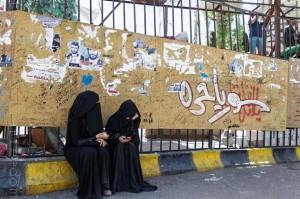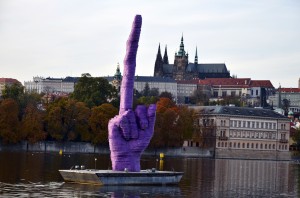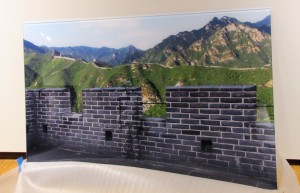Political art is far from a novel phenomenon, but nowadays we’re exposed to artist-activists from around the world, creating works of dissent and rebellion. Here are my personal favorites from recent years, and a brief look at the political context from which these social critiques have emerged.

5. Street art has become a popular platform for artists to reach the general public. The medium itself is illegal and thus inherently defiant to power structures, be it an oppressive government or an economic system. Notable artists like Banksy and French artist JR have come to prominence in recent years. Some of the most intriguing examples of street art have emerged during the Arab Spring, in which graffiti art has became a widespread form of protest. Yemeni artist and activist Murad Sobay created the 12th hour campaign — a series of street art murals, paintings, and graffiti pieces in response to the spread of sectarianism and social upheaval in Yemen. Sobay emphasizes the importance and power of street art, even in a conservative country like Yemen, and calls for awareness of social problems in a participatory way.

4. David Cerny, a sculptor in the Czech Republic, has created some visually impactful and provocative pieces. In one of his more notable works, Cerny placed a sculpture of a purple hand with its 16-foot-long outstretched middle finger facing the capital. This sign of disdain, unsubtly pointed at the state of politics in the Czech Republic, reflects Cerny’s disapproval of the mass corruption of Milos Zeman, a former leftist prime minister and current president of the Czech Republic. Another notable Cerny work is the Piss Sculpture in Prague, in which two mechanical men urinate on a map of the Czech Republic. Apparently, if you text a personal message to the number next to the exhibit, these men spell out the message in the water.

3. Ai Weiwei is likely the most famous political artist in world. He has relentlessly campaigned to bring justice to victims of China’s negligence after the 2008 earthquake, and to China’s repressive tactics in general. Though Ai Weiwei is the most renowned of Chinese protest artists, he is certainly in good company. A favorite of mine is Liu Bolin, whose body of work is based on the concept of “disappearance.” In his works, Liu’s own figure is often perfectly camouflaged in different landscapes, and thus difficult to discern. His work stands on its own as striking, but there are clearly thoughtful political dimensions to the work. Liu Bolin’s blending into the background speaks to a sense of anonymity and loss of individual identity in modern China.

2. Steve Lambert’s “Capitalism Works for Me!” uses a giant, attention-grabbing LED-lighted sign that brightly states. On the left side of the sign blares the word “True” and on the right side of the sign the word “False,” and beneath there is a score board. Everyday people come by and cast their vote. This interactive, mobile installation art is intriguing in that it is an experience for those who are voting as well as for viewers at home due to the video component. American’s from all different walks of life are confronted by a debate that is profoundly personal as well as political. The most interesting comments to me were at 5:08 (Margarite, who voted Yes), and right after Wiseley, who voted No at 6:37.

1. And finally, my personal favorite is Iraqi-born American artist Wafaa Bilal. In his a 24-hour live performance called …And Counting, Bilal received tattoos: one red dot for each of the 5,000 dead American soldiers killed during the Iraq War and one green UV ink dot, only visible under black light, for each to the 100,000 Iraqi casualties. And with each dot, names of the dead are read by passerby. Using his own body as a medium, Bilal comments on the American public’s negligence of Iraqi suffering and political censorship. This literal, permanent “inscription” of the dead on his own body is an incredibly powerful statement and further establishes art as a universal language of humanity.
Each of these artists, and thousands more, have created many works that speak to the most important political issues of today in a manner that is beautiful, personal, and deeply thoughtful. Whenever I explore these artists works, I’m reminded why global political problems belong to everyone.
